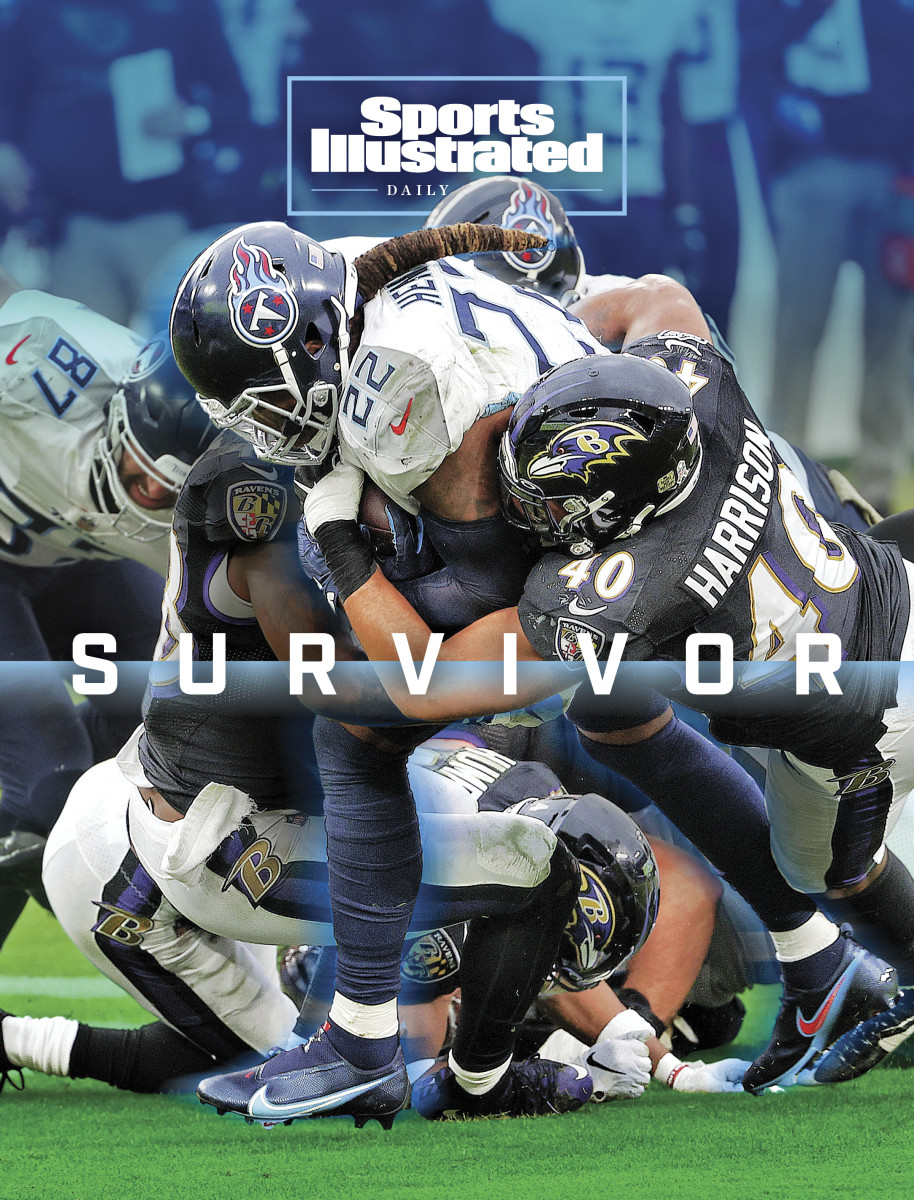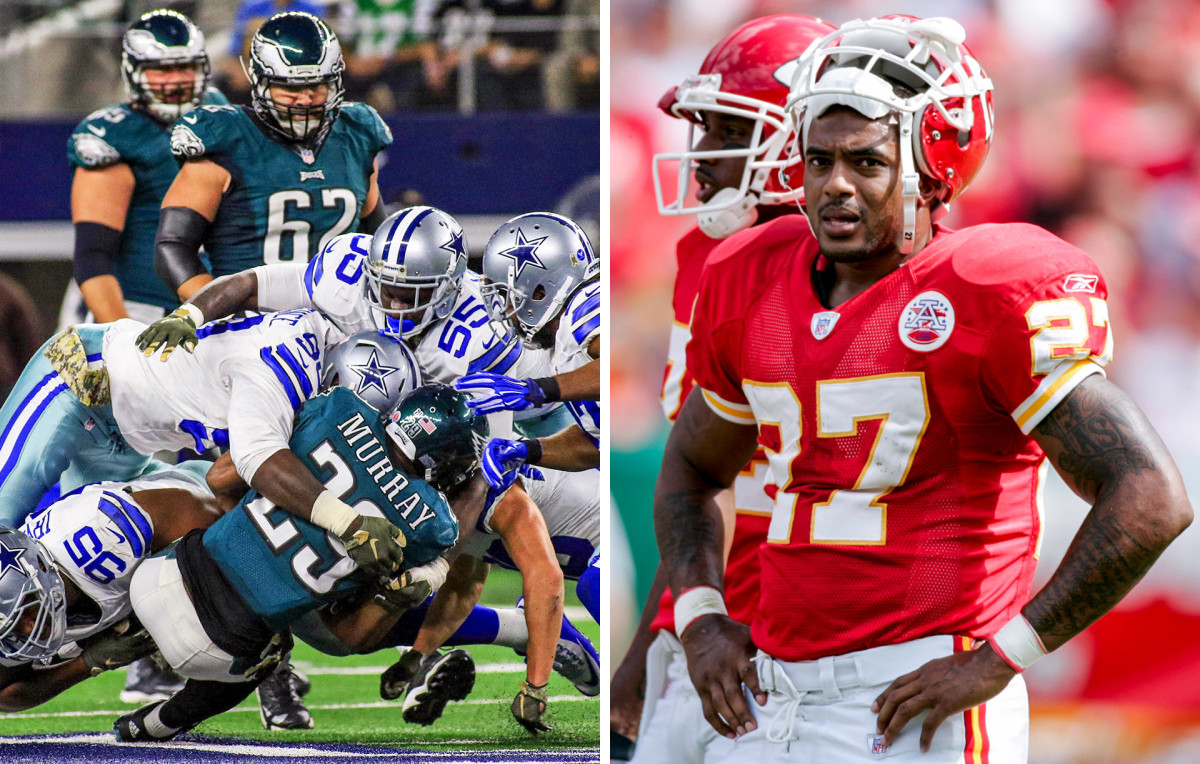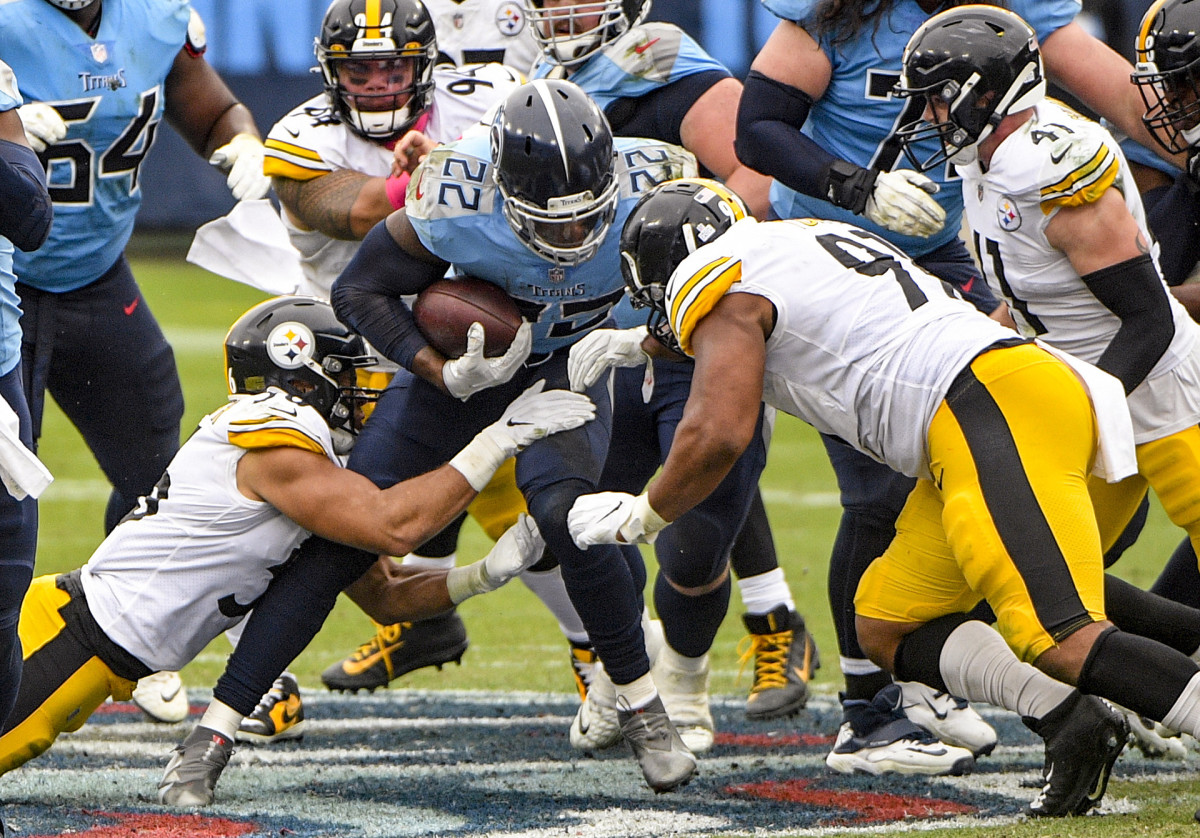How Derrick Henry Handles a Throwback Workload
Derrick Henry arrives at the gym wearing a black Dri-Fit turtleneck and long, black tights with high, white socks and a black skull cap that neatly covers the top of the thick, signature braid running down his neck toward the middle of his shoulders.
It’s a late-February afternoon. “Empire State of Mind” by Alicia Keys and Jay-Z plays over the loudspeaker at Dallas’s Sanders Fit Performance. Henry’s trainer, former professional basketball player Melvin Sanders, has agreed to answer pressing questions about the body’s limits in modern football, and how a 6' 3", 247-pound running back can withstand the workload that has resulted in back-to-back seasons leading the NFL in rushing yards and touchdowns.
Henry arrived here just two days after the Titans’ season ended with a wild-card round loss to the Ravens. In any workout setting, there are the classic, platitudinal gym rats who linger, tweaking every muscle, staring at themselves in the mirror. And then there is Henry, who arrives with little ceremony every offseason for tight, periodized sessions of recovery. He picked the place after a trial workout went well. After his prescribed routine is done he’ll search for some other way to shuffle around the place, competing with Sanders and needling him about his sport of choice. A basketball hoop and a set of cornhole boards in the center of the sprawling compound often serve as a catalyst for some of the most intense games of H-O-R-S-E the world will never see (Sanders says that Henry, a surprisingly solid jump shooter, insists he can play in the NBA right now, but notes that he has never lost to the running back). Sometimes, he’ll show up again later in the afternoon for another workout. “He’ll just stay here for an hour after doing shrugs and curls,” Sanders says. Other times, he’ll ask Sanders whether he knows of any large hills nearby that the two can run up together.

Henry is coming off a 396-carry season, which followed a 386-carry season (both totals including playoffs) before that. Not long ago, the 370-carry threshold was considered the position’s breaking point. The season after reaching that benchmark usually contained indicators of a steep decline before the wheels fell off entirely. Terrell Davis, after a 481-carry season followed by a 470-carry season, never played more than eight games in a season again. Shaun Alexander, following a 430-carry MVP season in 2005, never lasted 16 games in a season again. The same evidence of decline goes for Larry Johnson, after 429 carries in ’06 (the last 400-carry regular season we’ve seen), Natrone Means after 400 carries in 1994, Ahman Green after 403 carries in 2003. DeMarco Murray never eclipsed 300 carries again after a 416-carry season in ’14, though he did make another Pro Bowl, with the Titans, after a one-year flop with the Eagles.
And yet the Titans show no signs of backing away from their superstar back. Henry seems to be getting better, gaining more yards above expectation in 2020 than he did during his breakout season in ’19. He is built perfectly for Tennessee’s outside-zone rushing scheme, which lifts so many players in its orbit and has helped transform the careers of quarterback Ryan Tannehill, former offensive coordinator (and now Falcons head coach) Arthur Smith and star wide receiver A.J. Brown. Without Henry there likely would be no discussion of the Titans’ returning to the playoffs and surviving an offseason purge that included the departures of their play-caller, top tight end and No. 2 receiver.
Henry’s plan to avoid the workload curse seems twofold. The first, the Zen, is to ignore it altogether—“God has a plan for you. Just live it up,” he says—and the second might be birthed in these offseason workout plans. One could argue that his combination of size and speed is what got him to his moment; sometimes God just sends us a running back. For decade-long stretches of his life people were afraid to get in his way; those who did often became loose gravel underneath his tires.
Maintaining Henry is different. It’s taxing. And it determines what happens next.
“He’s the strongest he’s ever been,” Sanders says, before referencing a photo he took of the running back five years earlier, and how comparatively jacked he looks now. “He worked his ass off.”
VITAL AIR 5+
INNOVATIVE TECHNOLOGY FOR IMPROVEMENT OF VITAL FUNCTIONS
OVERLOAD
PROGRESSION
SPECIFICITY
VARIATION
REVERSIBILITY
BALANCE REACTION
Sanders texts as quickly as he talks, firing over months’ worth of workout planning in a matter of seconds. Maintaining Henry is not necessarily a full-time job—he comes off as the antithesis of an athlete who treats (and refers to) their body as an expensive Italian sports car—but it takes careful planning and consideration. Henry’s file, which contains various phase-planning, workout types, lengths and intensity levels, different recovery techniques and their inherent benefits, looks like one combined the contents of a workout supplement magazine ad with a birth planning chart. Macrocycles. Mesocycles. Performance. Recovery. And yes, for good measure, wrinkle reduction.
Ask Henry about his training, and he highlights the work. There are spartan elements, like those weighted jogs uphill, that he enjoys. But at his core, he likes to go somewhere and sweat.
“I pride myself on hard work, and I feel like when you work hard everything you want to accomplish will take care of itself,” he says. “I love working out. I love being fit. I love being in the gym lifting weights. I do all I can to come into the season ready to carry the load.”
Ask Sanders and he’ll emphasize the recovery. Anecdotally, he says, running backs had come to accept that their careers were going to be shorter and worked out accordingly. To capitalize on those tiny windows, they would jack their bodies up for a good three- or four-year run without incorporating the rest and various treatments that could potentially prolong their careers. Henry receives cryotherapy, red-light therapy, oxidative stress therapy and different IV nutrient therapy, all of which are said to promote healing. Or, at the beginning of a long string of notes from Sanders in his Henry file:
“PHOTOBIOMODULATION…Detoxification – Boosts Blood Circulation – Energy – Decreases Inflammation for muscles and joints – boosts mitochondrial function – promotes muscle recovery – improves muscle performance – decreases soreness – Boosts production of AdenosideTriphosphate & Nitric Oxide – Aids in Release of Natural Endorphins – Reduces Free Radicals – …”
On this otherwise banal morning at the gym, Henry begins the workout on his knees, shoes off, with a weighted cylindrical barbell in his hands. He lifts it over his head while swinging his right knee out in front of him, in a kind of sprinter’s stretch. He alternates a few reps with each leg for eight total reps before picking up a 35-pound medicine ball.
In the same kneeling position, he picks up the black weighted ball and begins slamming it down on the padded floor, over and over.
“Most guys put on a few pounds after the season,” Sanders says, watching as the running back begins to breathe heavily a bit, eventually discarding the ball under his thigh. “But he looks pretty lean.”
After that, Henry, still on his knees, hoists 40-pound dumbbells and begins hammer curling, holding the weights at his side and then lifting them up to his chest.

Henry grew up on the northeastern coast of Florida, tall and lanky, idolizing older cousins who were layered with muscle. They introduced him to the gym, and he became fascinated with the mechanisms behind strength development. He was not deterred from early experimentation, accentuating his glamour muscles.
“As a kid, you know, I was drinking [protein] shakes,” Henry says. “I’d do all these curls and all these push-ups and then a day or two later, I’d expect to look like Arnold Schwarzenegger or something. That was how it was as a kid. I wanted results fast, but I realized it took time.”
Now, the push-ups have a purpose. Here at the gym, he’s fashioned his hands in a diamond shape, hoisting his body up and down in an effort to work his triceps muscles. From there, the workout consists of 30 repetitions of pounding a heavy, weighted rope into the ground with each hip alternately pressed against the wall (Henry is in a seated position with no chair underneath). He then reclaims the medicine ball and starts hurling it five feet away at the cinderblock wall. He curls an 85-pound straight bar (toward the middle of the offseason, he will do consistent reps with 110 lbs.), pulls, from a kneeling position, a resistance band attached to a bolted-down machine to work his abs and does more long medicine ball tossing, this time with a push-up at the end of each release. Sets of 25 quick rope slams end the session after almost an hour.
This is Phase 1 of the Henry offseason plan, which, which in Sanders’s notebook is described as STABILIZATION, tempo, lower weight, and higher reps in an unstable but controlled environment.
He agrees that this is the ground-level formulation of Henry’s arsenal—most notably, the stiff arm he so often thrusts into opponents’ chests. Running back longevity is easier to achieve when opponents are ricocheting off him like balloons caught in a ceiling fan. Henry’s obsession with his own strength organically produced this moment where he can now defend himself with incredible regularity and fortify said defense mechanism every offseason.
“Everybody has that one thing they’re good at and they’ve mastered,” Henry says. “The stiff-arm, that’s something that always came naturally. Now that I’m in the league, everyone is on notice about it.”

Toward the end of a set of straight bar curls, Henry’s eyes begin to close, and his teeth clench. He’s worked up the requisite sweat, nearing the end of his workout. Sanders stands a few feet away to offer encouragement.
“Aw yeah, we in the gym now!” he says to his client, before muttering under his breath: “He’s strong as s---.”
Phase 1 of the Henry Maintenance Plan will bleed into Phases 2 to 4, which is called the Strength Phase. Henry lifts “moderate to heavy weight with low to moderate reps with full range of motion.” Phase 5 is called the Power Phase with something Sanders calls “undulating periodization,” which means Henry will complete high-intensity workouts on Mondays, low-intensity stabilization workouts on Wednesdays and moderate-intensity strength workouts on Fridays.

Such is life for someone who steps on the field each season looking like a wheelbarrow full of sculpted granite. His body type, much taller and heavier than most running backs, raises all kinds of questions about the advantages it lends to longevity, and whether he is, simply, genetically superior. Are we witnessing, like we have at the quarterback position, the benefits of positional evolution? Could Henry be a catalyst for more grade-school behemoths to demand the ball 40 times a game, honing their skills as a running back, resisting the conversion to defensive end?
“That’s why you play this game,” Henry says. “To inspire a younger generation ... I always tell the kids to be better than me. Don’t be just like me.”
Or, is the work here in the gym tapping into a kind of secret sauce of running back longevity? Is that even possible, or are we doomed to exist in the current, unsatisfying reality that the Henrys, Adrian Petersons, Jerome Bettises and Walter Paytons of the world arrive like a rare cosmic anomaly, teasing coaches into believing that sustainable power football has returned, and the passing explosion was just some regrettable fever dream?
Sanders says that rule changes in the NFL, plus advancements in recovery technology, have legitimized his confidence in a long-term vision. His plan, which took to the rolling hills outside Dallas later in the summer months, forced Henry to push his body toward its outer limits as he fatigued to simulate an increased number of consecutive carries. Four, five, six downs in a row that the Titans could ask him to plow forward.
And no one seems worried.
“He takes care of his body like no other,” Sanders says. “He’s very in tune with his body. He knows what he needs to do.”
When Henry talks about the future, he still uses somewhat guarded terms. Twice in a question about what he wanted to improve on this season, he mentioned what happens next in terms of “as long as I can play this game.” In that way, he does not yet have the luxury of a Tom Brady, who can walk off the field comparatively unscathed and say, with confidence, that he would like to be in uniform beyond his 45th birthday. Those conversations have not yet been extended to those who don’t throw or kick a football.
Still, that will not deter Henry and Sanders from trying. As a pair of weights landed with a thud and Henry stretched back to a neutral posture, he looked the part, like someone who will arrive here around the same time next year, two days after the season ends, to start the process of defiance again.
• Copycatting the NFL’s Trendiest Offense Is Harder Than You Think
• Dak Prescott’s Heal Turn
• The NFL’s Problems With the Deshaun Watson Investigation
